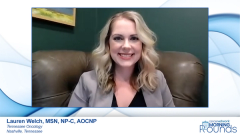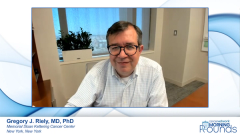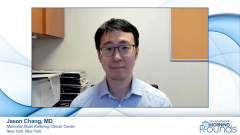
Molecular Testing Assays in Non-Small Cell Lung Cancer
Expert oncologists provide a comprehensive review of available biomarker testing assays utilized in patients diagnosed with non–small cell lung cancer.
Episodes in this series

Transcript:
Gregory J. Riely, MD, PhD: Welcome to this CancerNetwork® presentation, “Morning Rounds: Non–Small Cell Lung Cancer EGFR Testing and Treatment.” I am your host, Dr Gregory Riely; I’m a thoracic oncologist and the vice chair of clinical research at Memorial Sloan Kettering Cancer Center [New York, New York] in the department of medicine. I’m happy to have 2 colleagues joining me today, Jason Chang from Memorial Sloan Kettering, and Lauren Welch from Tennessee Oncology [Nashville]. If you both could please introduce yourselves, Jason?
Jason Chang, MD: Sure. My name is Jason Chang; I’m a thoracic and molecular pathologist at Memorial Sloan Kettering Cancer Center.
Gregory J. Riely, MD, PhD: Great. And Lauren?
Lauren Welch, MSN, NP-C, AOCNP: Sure. My name is Lauren Welch; I am a nurse practitioner at Tennessee Oncology. I specialize in lung cancer and I’m a subinvestigator in the drug development unit at Sarah Cannon Research Institute in Nashville, Tennessee.
Gregory J. Riely, MD, PhD: Great and thank you again for both being with me today. We’re going to focus our discussion on testing and how testing affects treatment for patients with non–small cell lung cancers. We’ll begin by talking about some basic concepts, and then we’ll go through 2 different clinical scenarios and think through best practices along the way.
I wanted to start by thinking through a patient who walks in the door with a diagnosis of non–small cell lung cancer. What do you need to think about for that patient? What are you going to look at in their past medical history, and what type of testing do you want to do? I’ll talk through how I think about a patient with non–small cell lung cancer, and I’m happy to hear some other thoughts along the way. Really, it’s the basics of cancer. What kind of cancer does the person have? What stage does the patient’s tumor look like it is? And then a little about the patient characteristics, they’re going to help me understand the relative value of various biomarker testing.
When I see a patient up front, I used to think that if they had stage I through III cancer that I didn’t really need to focus too much on biomarker work because the pathway forward didn’t depend on that. But more recently with data suggesting the role for neoadjuvant chemotherapy plus checkpoint inhibitors, where patients with EGFR and ALK [mutations] were left out of the study, or where you might find value from PD-L1 testing to understand benefits, we need to know these things, even in the earliest stage setting. But of course, the majority of the work for biomarkers has come from the advanced disease setting where we focus a lot on things such as PD-L1 and molecular testing. Jason, let’s talk a bit about the molecular tests that we do for patients with non–small cell lung cancer. You can run through the whole range of things.
Jason Chang, MD: Sure. I can start by discussing some different platforms of molecular testing. There are the driver gene-only panels and also the NGS [next-generation sequencing] panels. Obviously, the driver gene-only testing will just tell you the main driver alterations, such as EGFR, ALK, ROS1, those things. Then the NGS will cover those plus additional information, such as passenger mutations and secondary alterations, or additional tumor suppressor genes as well. It gives us a more comprehensive picture of the entire molecular profile. Given that there are 8 biomarkers that we must test for, it is very difficult to run sequential driver-only testing without exhausting all the limited tissue, especially for small biopsy samples. Therefore, right now NGS has become the recommended platform for this type of testing in most scenarios.
Gregory J. Riely, MD, PhD: When you think about some of these tests, you’re really talking about this tradeoff between comprehensiveness and a more directed panel. I think when Lauren and I are facing the patients in the clinic, one of the things that often comes up is the time angle. What thing is going to happen quickly? They don’t want to wait; what do we do next? How does that factor in?
Jason Chang, MD: That’s a great question. Right now, our NGS panels would probably have an average turnaround time of about 3 weeks. Obviously, that’s suboptimal from your standpoint. At MSK [Memorial Sloan Kettering] at least, we combine both approaches. We have the small panels giving you the answers for EGFR, KRAS, and ALK within 2 to 3 turnaround days. We also run the NGS panels at the same time, and then we would be able to provide you with a comprehensive evaluation of the molecular profile in about 3 weeks. Right now, that’s our approach, to provide you with a quick answer covering the most important driver alterations, but at the same time trying to limit the tissue exhaustion issue. We can address both at the same time.
Gregory J. Riely, MD, PhD: Right. One other thing that comes up is, what is the right material to do some of this molecular testing on? I know that for the longest time we focused on using tissue, because that was the main way we did this, but over the last year, there have been several approaches that try to get a result based on plasma DNA. These different approaches have different sensitivity specificities, and different turnaround times as well. Can give your perspective from the pathology side?
Jason Chang, MD: The main issue here is liquid biopsy or ctDNA [circulating tumor DNA] testing versus tissue-based testing. We have done tissue-based testing for a long time, so we are quite familiar with the performance of tissue-based NGS assays. We have only started doing liquid biopsy in the last few years. With liquid biopsy, the main issue is sensitivity. It depends on how much DNA is shed into the plasma. It depends on the size of the tumor and the stage of the tumor as well. For early stage tumors, the sensitivity is going to be a bit lower. However, there have been many studies showing the high concordance between liquid biopsy results and tissue-based NGS testing, so the accuracy is not so much of a concern, it’s really the lack of sensitivity in the liquid biopsy setting. I would probably recommend that if you wanted to do a liquid biopsy up front, that’s totally fine. But if the result is negative on liquid biopsy, then you should consider still sending tissue for NGS testing.
Gregory J. Riely, MD, PhD: Yes, that makes a lot of sense. I think this challenge of sensitivity, the question is a technical challenge, right? Is the assay you’re using to test the blood sensitive enough to pick it up? But it’s also the biological issue of, is this patient’s tumor the kind that sheds DNA into the bloodstream? You mentioned some predictors of that, such as tumor burden and sites of disease, but they’re 2 totally different things. For some patients, their tumors are just never going to shed. In that approach, no matter how good the liquid biopsy is, it’s not going to get you an answer.
Jason Chang, MD: But I also wanted to mention that in some settings liquid biopsy is superior to tissue-based testing because it reflects the global disease burden in the patient. So you don’t have to sample multiple tissue sources to demonstrate the required resistance mechanisms, for example. Oftentimes, you’ll be able to get a broad picture based on the liquid biopsy profile.
Transcript edited for clarity.
Newsletter
Stay up to date on recent advances in the multidisciplinary approach to cancer.


















































































